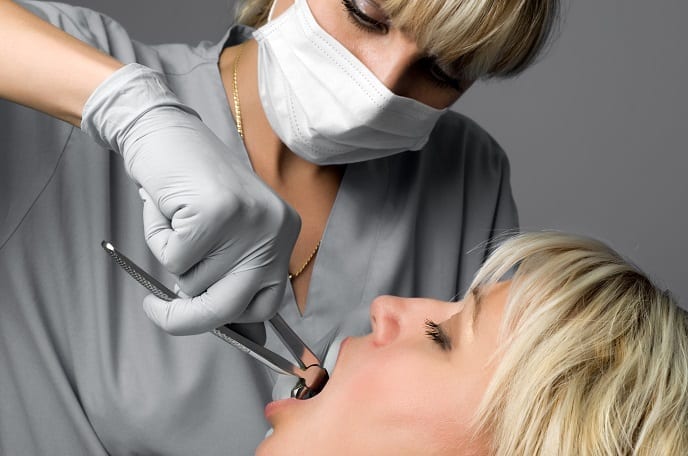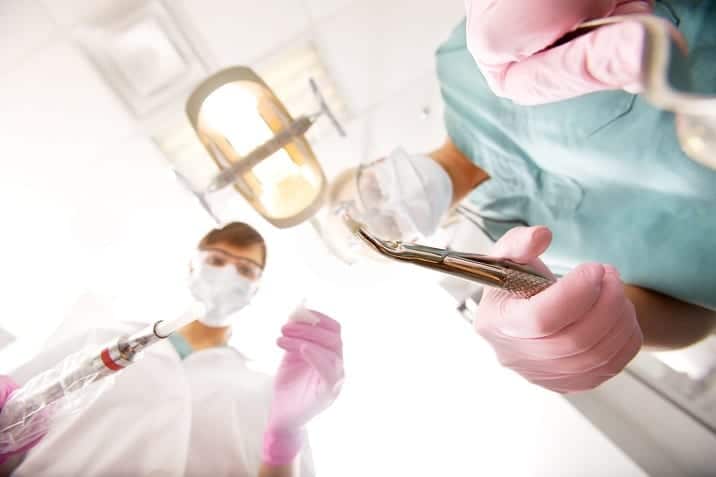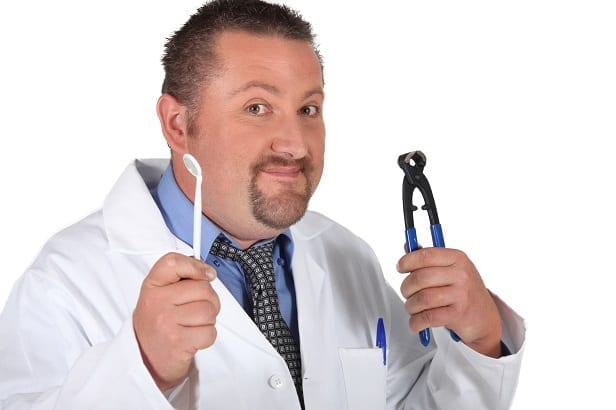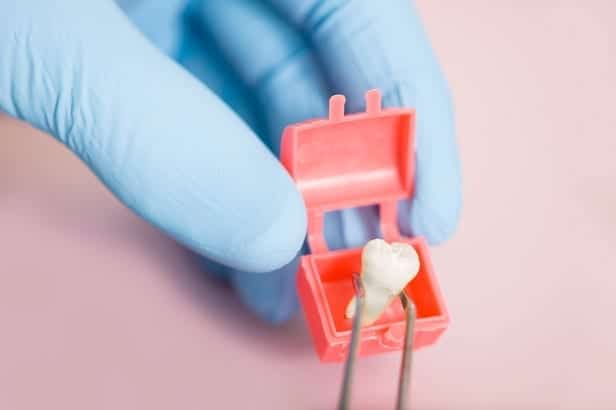You can fix a tooth that’s cracked without any problems. However, some cracks don’t exhibit symptoms, so you have no idea they’re there until they completely break apart. That’s one of many reasons why there are times when you have no choice but to pull out a permanent tooth. It’s meant to last a lifetime, but if you don’t care of it then extraction might be needed. It’s not enough to put tooth filing over it or place a crown to cover and protect it as far as repair is concerned.
Certain teeth cannot be saved. Anytime a tooth is too badly damaged from decay, trauma, or both, then it needs repair or extraction. Get a competent dentist to do the procedure if it’s called for. He’ll tell you your options for
Reasons You Might Need a Tooth Extraction
It’s usually not ideal to undergo a dental extraction because the dentist is there to do everything he can to save your teeth. With that in mind, here are the most common reasons why people undergo a tooth extraction.
- You Broke Most or All of Your Tooth: If this is the case then your dentist won’t be able to glue your tooth back together with composite resin because it will come apart again due to the bite forces of your mouth. This is especially true to teeth that have shattered into multiple shards. An extraction can remove the tooth or its remaining pieces out. You might need to get a dental implant or a bridge depending on the location and tooth type.
- Your Tooth Is Too Unhealthy to Save: If the tooth has suffered from too much decay and is no longer healthy then you might want to get it extracted. This is because a severely decayed tooth material affected by gum disease and whatnot might have destroyed enough enamel, dentin, and bone to the point that the tooth is no longer supported by your jaw and tooth socket, so it’s best to remove it altogether and cut your losses rather than try to save it. It’s too late for that tooth. You need a new avenue of restoration.
- Infection and Infection Risk: If the decay extends all the way to the pulp—otherwise known as the tooth center where all the blood vessels and nerves are—then that necessitates extraction. This is usually corrected with root canal or endodontic therapy. However, there are times when the infection is too severe that neither antibiotics nor the procedure can treat it; in these cases, extraction is usually needed to prevent the spread of infection. You can also remove diseased teeth if you’re immuno-compromised and are an infection risk as well as if you’re suffering from periodontal disease.
- Your Mouth Is Too Crowded: There are times when dentists might pull out certain teeth from your mouth in order to alter your bite or to keep the teeth from crowding too tightly amongst themselves. There is such a condition as having too many teeth. Teeth might be pulled as well to prep your mouth for orthodontic devices. The goal of orthodontics is to align your teeth properly, which might be impossible if your teeth are too big or crowded for you. Furthermore, your dentist might recommend pulling certain teeth if the teeth underneath have problems erupting or breaking through the gums.
- Your Wisdom Teeth Are Growing the Wrong Way: If your wisdom teeth becomes impacted or unable to erupt from under your gumline, it might also end up growing sideways altogether, resulting in various nasty conditions such as bacterial formation in certain pockets of your mouth as well as lots of pain. It can be placed badly in your mouth or erupt right into your sinus cavity. This is usually because the modern human jaw has no space for them to grow. Have your dentist x-ray your mouth and take note if these back molars are exhibiting such serious issues.
- The Other Ways Your Wisdom Teeth Can Screw You Over: Even if a wisdom tooth or teeth were to erupt normally, the dentist might suggest removing it anyway because they might overcrowd your teeth regardless. If you lack space for proper maintenance, like the floss or toothbrush unable to reach the tooth, then that can lead to tooth decay, cavities, and tooth death as well. You’ll need them extracted before they become impacted because when impaction occurs you’ll need dental surgery to remove them.
- A Cracked Tooth Progressively Gets Worse: Just like how a chair repairman will warn you that a cracked chair isn’t as sturdy as before even after repairs have been done on it, so too is the case with a repaired cracked tooth. Once you damage a tooth, it will never be as tough as when you first got it. A broken tooth’s damage will progress over time until it’s completely divided. Therefore, the dentist will recommend an extraction for teeth with compromised structural integrity of the tooth material and extensive cracks.
Types of Tooth Extractions

Even though tooth extractions might appear very invasive for some, they’re sometimes the best course of action as far as maintaining your oral health is concerned. You will come across two types of tooth extractions. They include the following.
- Simple Extraction: The dentist just pulls the whole tooth or certain tooth fragments visible above the gum line. This extraction type is done for people with teeth that have already erupted and present for pulling with minimal complications afterwards. The tooth is removed in the routine way of applying anesthetic and simply pulling it out with dental pliers.
- Surgical Extraction: This procedure is used for more complicated issues and conditions, when the teeth to be extracted are harder to remove This includes removal of teeth with curved roots, teeth broken at the gum level, and teeth that haven’t erupted yet. And can only be seen by dental x-ray. Surgery is also called for when bone needs to be removed next to the tooth before extraction is possible. Most often, surgery involves cutting the gumline and stitching it back together again for the sake of proper healing.
After extraction is done, expect to end up with an empty socket where your tooth used to be. During the recovery period, you might experience dry socket where pus forms on the area. Go back to your dentist to drain this bacterial infection. This is your biggest concern as you recover, but it should disappear on its own. Follow dentist advice of things to do and not to do and you should have a full recovery sooner rather than later.
What to Tell Your Dentist Before You Have a Tooth Pulled
Even though tooth extraction is typically safe, this process can lead to bacteria ending up in your bloodstream due to your open mouth wound. Aside from dry socket, you also risk infecting your gum tissue with bacteria. If you have a preexisting condition that puts you at risk when it comes to severe infection development, you might require taking antibiotics before and after you’ve gotten your tooth extracted.
Furthermore, before tooth extraction commences, tell your dentist your complete medical history, including any conditions you might suffer from such as heart ailments, asthma, and any allergies. Also tell him the supplements and medications you take. To be more specific, tell your dentist if you have one of the following conditions:
- Congenital heart defect
- Liver disease (cirrhosis)
- Impaired immune system
- History of bacterial endocarditis
- Damaged or manmade heart valves
- Artificial joints, such as a hip replacement
After You Have Had a Tooth Pulled

After extraction is through, your dentist will send you to recover back at your home. Recovery time can last for a few days barring complications. In order to induce a speedy recovery, minimize your pain, and avoid dry socket as well as other infection types, you should do the following.
- Pain Pills: Take your prescription painkillers as recommended by your dentist.
- Avoid Straw Drinking: Don’t drink beverages from a straw for the first 24 hours after extraction.
- No Smoking: Don’t smoke after getting your tooth pulled because that inhibits the healing process.
- Gauze Replacement: Regularly replace your gauze before they become soaked with blood and saliva.
- Salty Mouth Rinse: After 24 hours have passed, rinse your mouth with a solution composed of 8 ounces of water per ½ teaspoon of salt.
- Bite The Gauze: Reduce bleeding and encourage a clot to form in the tooth socket, bite gently but firmly on the gauze pad given to you.
- Leaving The Gauze Pad In: You can leave your gauze pad on the extraction area for 3-4 hours after extraction is through barring excessive blood soakage.
- Elevate Your Head: As you lie down on your bed, prop your head up with your pillows. Bleeding will tend to be prolonged when you lie flat on your back.
- Rest and Relaxation: Relax for a whole day or 24 hours immediately after the procedure is through. Limit your activity the next day or few days after extraction.
- Ice Bag: Immediately apply an ice bag—about 10 minutes at a time—to the affected area or your cheek next to the extraction site after extraction to keep down swelling.
- Eat Soft Foods: On the day after the extraction, you should eat soft foods such as yogurt, pudding, applesauce, soup, and broths. Gradually introduce solid foods to your diet as the extraction area heals, from soft to tougher meats and vegetables.
- Avoid Forceful Rinsing and Spitting: When applying mouthwash or brushing your teeth, avoid rinsing or spitting forcefully within 24 hours after the procedure to prevent clot dislodgement and encourage clot formation on the socket itself.
Continue your daily dental hygiene habits like brushing and flossing your teeth as well as brushing your tongue. However, avoid contact with the extraction site and the forming clot on it. This will prevent agitation of the wound and eventual infection when push comes to shove.
When to Call the Dentist
It’s normal to feel pain from the extraction site after the anesthesia wears off. Within a day or 24 hours after tooth extraction, you should brace yourself for some residual bleeding and swelling. No need to consult with your dentist around that time. Alas, if pain or bleeding remains severe for more than 4 hours after tooth extraction, then that’s the time to consult your dentist.
You should also contact your dental professional in case the following things were to happen to you after your tooth has been pulled and whatnot.
- Mild to severe vomiting or nausea
- Chills, fever, and other signs of infection
- Excessive discharge, swelling, or redness from the affected area
- Chest pain, shortness of breath, coughing, and other signs of allergy
It takes 1-2 weeks for the extraction site to fully heal. During this time, the gap will have gun tissue and new bone grow all over it. As time passes by, having a tooth or teeth missing can cause shifting from your remaining teeth, affecting the shape of your bite or possibly giving you issues with chewing. This is why dentists might recommend replacing the missing teeth with a denture, fixed bridge, or implant.
The Bottom Line

If your tooth has become too damaged to save with even a root canal then you can undergo a procedure known as tooth extraction. It involves the complete removal of the tooth from your mouth. In the case of milk teeth, some dentists can remove the tooth instead of waiting it to fall out, and in such cases the loss of the tooth is temporary. It’s supposed to fall to make way for the larger permanent teeth of the child that’s growing to adulthood.
However, there are times when your permanent teeth suffer so much damage that it’s necessary to remove them through a process known as extraction. With that said, when you remove permanent teeth, your body doesn’t replace it with new teeth. You’re permanently toothless in that area of your mouth until you put in a denture, bridge, or dental implant with crown over it to cover up the loss of your natural tooth.
Thantakit International Dental Center is Thailand’s longest established dental center. Situated in Bangkok, our clinic is renowned across the world as a destination for world-class dentistry, with most of our patients flying to us from Australia.
Please contact us today and get a FREE dental consultation.













